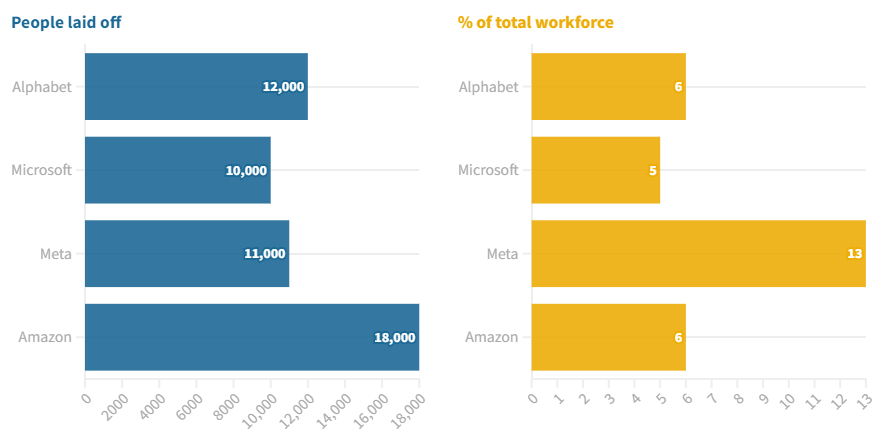Global layoffs and impact on India
2023 JAN 31
Mains >
Economic Development > Indian Economy and issues > Information technology
IN NEWS:
- Several technology companies, including giants like Google-parent Alphabet, Amazon, Microsoft, and Facebook-owner Meta, laid off more than 1,50,000 employees in 2022 and over 40,000 in January of this year alone.

WHY THE LAYOFFS:
- Post-pandemic moderation:
- The advent of the coronavirus pandemic brought along rapid growth for the digital tech sector. However, it gave the false impression that the digital spike would be permanent and so, companies hired aggressively. Now, companies are rightsizing their headcounts.

- Declining profits:
- Analysts project that the five big tech companies are headed to report dismal profits for the October to December (2022) period.
- For instance, a Reuters analysis states that Amazon is expected to report that earnings fell 38% and revenue grew at the slowest pace in more than 22 years.
- Improve investors’ confidence:
- In recent times, tech companies have seen their stock prices plunge. The layoffs are meant to send a message to shareholders that the companies are being prudent, and want to come back to a growth path after overzealous spending.
- Growth of AI:
- Tech companies have made significant investments in Artificial Intelligence-driven tech in the recent past. This could reduce the demand for human resource in the coming years.
- For Instance, Microsoft recently confirmed that it is making a “multibillion dollar” investment in OpenAI, the company behind the viral new AI chatbot tool called ChatGPT.
- Inflation targeting:
- Governments and central banks across the world have been taking measures to bring down inflation. Since inflation and employment have an inverse relationship, these measures could lead to higher unemployment levels.

- ‘Funding winter’:
- In 2022, funding has started to dry up due to global macro-economic factors like the Ukraine-Russia crisis, fear of recession and increase in interest rates by central banks. Hence, companies, particularly startups, are moving to layoffs, forced mergers and acquisitions.
- Change in ownership:
- Some companies witnessed takeovers and mergers, resulting in layoffs. Eg: Twitter saw layoffs in the aftermath of Elon Musk’s turbulent takeover.
- Simple regulatory regime:
- US companies seem more open to layoffs since the country has a liquid labour market and labour laws too are not that stringent.
IMPACT ON INDIA:
- Unemployment:
- Between 30% to 40% of those laid off in the US are Indian IT professionals, a significant number of whom are on H-1B and L1 visas. A sizeable number of them are now scrambling for options to work and stay in the U.S.
- The layoffs can also have consequences for families, like disruptions in children's education and panic selling of properties abroad.
- H-1B Work Visa: https://www.ilearncana.com/details/H-1B-work-visa/1676
- Layoff in Indian firms:
- The Indian IT services firms are among the largest employers in the organised sector and any global economic trend is bound to have an impact on their growth projections. In fact, layoffs are visible in the Indian start-ups, predominantly in EdTech.
- Reduction in employment benefits:
- Apart from slower hiring, increments would slow down, companies may delay on-boarding of candidates and would have tighter appraisal processes.
- Impact on mobility of labour:
- Along with layoffs, several companies like Google are pausing the processing of Green Cards. This could reduce the opportunities available for Indian professionals abroad.
- Impact on Startups:
- Tech giants play an important role in developing a good ecosystem for startups, through venture capital, incubators, R&D, mentorship and training. These activities could be affected due to decline in profits.
- Read on India’s Startup Ecosystem here:
https://www.ilearncana.com/details/India%E2%80%99s-Startup-ecosystem/3936
CONCLUSION:
Tech companies represent about 2% of all employment in the US. However, US labour department data shows the larger U.S. job market is robust and still hiring. Also, for Indian IT firms, roughly one-third of revenue comes from financial services. This sector has seen little change in terms of job additions in recent times. However, India can still utilise the current scenario into an opportunity, through:
- Identify talent:
- Attract companies to India:
- Considering the cost advantage that Indian talent has, companies that are downsizing globally might evaluate options of hiring/reallocating work to India. To facilitate this, India needs to emerge as an attractive destination for doing business. For this, regulatory, governance and economic reforms are essential.
- Upskilling and reskilling:
- As the job market is changing with the advent of new-age tech across sectors, Indian employees will need reskilling and upskilling. The skill India mission needs to be leveraged to cater to this demand.
PRACTICE QUESTION:
Q. Several global IT firms have laid off its employees in recent times. Analyse the reasons behind the layoff. How will the layoffs affect India?


